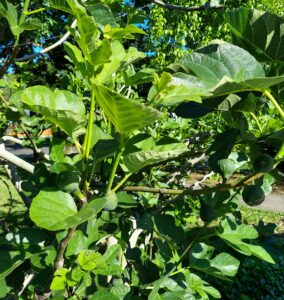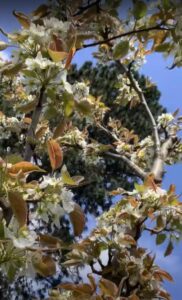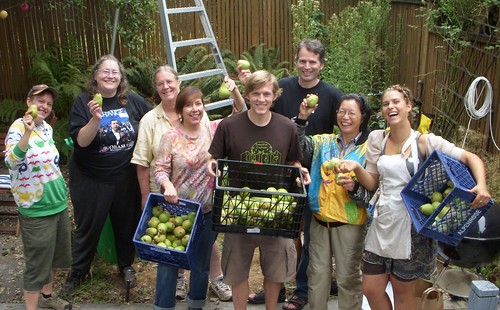Tag: fruit trees
Growing fruit trees is a rewarding hobby

“I love being able to go outside and grab a fresh piece of fruit for a snack – it’s healthy, seasonal, organic, and free.”
-Andrew Land (he/him), Neighborhood Trees Senior Specialist and home orchardist
Home orchardry is a rewarding hobby. Growing and maintaining fruit trees keeps you active, gets you outside, and provides fresh food. Fruit trees are also great trees for small spaces where larger trees just won’t work. Friends of Trees plants about 400 fruit trees every season, and they are an increasingly popular choice for yard trees.
Fruit trees are also a lifestyle—it’s a healthy one, but also one that requires regular, active involvement. As Andrew emphasizes, “Fruit trees are high maintenance. Growing fruit trees is a great lifestyle, but it’s not for everybody.”
Fruit trees require annual pruning, and they are pruned very differently than other trees. They also require extra attention: Home orchardists need to be on the lookout for pests & disease.
Location, location, location! Where fruit trees are planted makes a difference, particularly in terms of sun exposure for species susceptible to fungal disease. For instance, it’s ideal to plant fruit trees that are prone to fungal disease (e.g., European pear, some plum, some apple trees) in a location that gets early morning sun so that overnight dew on leaves has a chance to dry, thus offering some protection from fungal disease.
Friends of Trees works to source pest & disease resistant varieties, and provides all new fruit tree recipients with tree care information specific to fruit trees. However, it’s important to keep in mind that all fruit trees will always require extra monitoring and care (and resistance does not = immunity).
Still interested in growing fresh fruit in your own backyard?
In a typical season our top two recommended fruit trees are fig and persimmon. Why? Essentially they are the most pest & disease-free, they require less water, and they are generally low-maintenance. Another bonus of the persimmon tree is that it provides the last fruit of the year and so lengthens the season of food from your garden. If you’re up for more maintenance we usually also offer apple, plum, and pear trees. All of the fruit trees we offer are on semi-dwarf root stock because it is more drought tolerant than dwarf root stock and the roots of semi-dwarf stock anchor the tree more effectively.
By early fall we’ll know what fruit trees we can offer for the upcoming planting season since fruit tree availability varies largely due what’s available from the local nurseries we work with. On our wish list is the early ripening pawpaw, and if you’ve tried this special fruit you know why: pawpaws (which, fun fact, are the largest fruit native to North America) taste like a cross between mango and banana – !
Unlike most of the trees we plant, the cost of fruit trees is not supported by our municipal partners, who prioritize planting the largest trees possible because larger trees provide greater public health benefits. So beyond the $35 co-pay from tree recipients (which is waived if cost is a barrier to a household getting a tree), Friends of Trees is actually subsidizing fruit trees. Why? There are many benefits to growing fruit trees and, ultimately, we want people to grow trees.
More fruit tree resources are available from our friends at the Portland Fruit Tree Project.
Photo: Fig tree in an urban yard, June 2021 | Video: Jenny’s love letter to her Asian pear tree
Fruit Tree Care

Have you recently planted a fruit tree? Wonder how to care for it? Presenting Fruit Tree Care 101, by Neighborhood Tree Team member and fruit tree expert Andrew Land:
Welcome to the wonderful world of home orchardry! It will not be long before you are enjoying the fruits of your labor in the form of delicious apples, pears, Asian pears, pawpaws, persimmons, and figs (the species FOT plants, but this information can apply to all fruit trees). Not only will you eventually be enjoying a steady supply of fruit, but you are also enjoying all of the economic, environmental, and social benefits that trees provide.
Fruit trees in general have some unique maintenance needs in terms of pruning, harvesting, and pest/disease management. Simply left alone, fruit trees may become more of a burden than an asset. Luckily, there are several great resources in our region to help get you and your new fruit tree(s) off to a strong start.
If you don’t already know the fundamentals of how to be an orchardist, the Home Orchard Society is a great resource for fruit tree care through its website and workshops. Additionally, the Oregon State University Cooperative Extension allows you to “ask an expert” your fruit tree questions, and if you’re north of the Columbia River the WSU Extension website has some great resources on a variety of fruit-related topics. Finally, Portland Fruit Tree Project is also a fantastic resource.
Your fruit tree will need annual pruning to ensure a regular crop and unlike a shade tree, fruit trees should be pruned the first few years they’re in the ground to establish strong architecture before the onset of fruit. We’ve distilled some of the basics of pruning into a concise basics of fruit tree pruning flier that you can print and take with you out to the garden. If you’re inspired to go more in depth or have additional questions, here’s a more in-depth fruit tree pruning basics video from an OSU Master Gardener & Clackamas College.
Beyond that, keep in mind that on your new fruit tree you should be able to make all of your cuts with bypass-style hand pruners (at left in this image) that have two blades as scissors do. Please note that anvil-type pruners are not intended to be used on live wood.
Properly planting and caring for a fruit tree is a commitment, but one that is definitely worth the effort. Questions? Feel free to email me and I’ll do what I can to help.
Pictured above: Asian pear tree in glorious bloom.
Neighborhood Trees Program FAQ
 Some of the Why, Where, and What-Have-You of planting trees in the city with Friends of Trees
Some of the Why, Where, and What-Have-You of planting trees in the city with Friends of Trees
Since 1989 Friends of Trees has been growing our urban canopy through planting street and yard trees in neighborhoods. A LOT changes during 30 years of tree planting! We continually work with our city and county partners to ensure the right tree is planted in the right place, and since every location is different we are used to getting quite a few questions. Here are answers to some of the questions we get the most:
I want a smaller/larger tree for my planting strip but all the trees on this list are just too big/small, why can’t I get a smaller/larger street tree?
We work closely with our municipal partners and we can only plant trees that are on their approved street tree planting lists. One of the goals of our program, and the partners we work with, is to increase the urban canopy in order to maximize the benefits. In other words, the larger the tree, the more the urban canopy grows, which provides more benefits in terms of cooling in the heat of summer, providing oxygen, and cleaning our air and water. So when a planting site allows it we need to optimize the size of the tree planted, and consequently, maximize the benefits provided. We also want to make sure we aren’t planting trees that are too big, in order to protect existing urban infrastructure. So these same guidelines ensure we aren’t planting over-sized trees in spaces that are too small.
I want to plant a fruit tree in my planting strip and I know you have them, why aren’t they on my list of approved street trees?
Fruit trees are only approved for certain spaces, such as yards or planting strips that are six feet or larger and have overhead primary power lines (however, Vancouver and Clark County do not allow fruit trees to be planted as street trees at all). If you’d like a fruit tree for your yard in addition to your street tree, we offer a wide variety, including apple, pear, plum, fig, and persimmon.
I only want native trees for my street tree and you only have one native on this list, why don’t you plant more natives?
Right Tree Right Place! We love native trees, but many tend to get pretty big and just won’t work in some planting locations due to overhead power lines, if the strip isn’t wide enough, a nearby intersection, etc. We want to make sure your tree is the best tree for your planting spot! We also want to plant as diversely as possible toward a resilient urban forest. P.S. Want to plant some natives? Join one of our Green Space planting events–all natives, all the time.
I want a street tree, but will it break the sidewalk?
Again, Right Tree Right Place! The trees offered by Friends of Trees do not have aggressive root systems and are specially approved to minimize such conflicts. Proper watering also helps. Deep watering for the first three years after planting encourages tree roots to grow deeper in the soil, we recommend 15 gallons a week during the summer for the tree’s first three years, and as needed in the future when temperatures are extreme. Keep in mind that we cannot guarantee that the trees we offer will never buckle sidewalks, as they are living beings and situations vary. We do our best and encourage you to keep an eye on your tree.
I’m concerned that tree roots will damage the sewer pipe, doesn’t this happen?
A tree’s roots grow where the growing is easy, they are opportunistic and not invasive. They do not seek out water or sewer pipes unless the pipes are leaking. Further, 90% of tree roots are in the top 2-3 feet of soil, and most sewer lines are deeper than that. Your municipal tree inspectors take into account the location of your water meter and assigns the planting location within the guidelines of the water company.
Can you help me remove a tree so I can plant a new one with you?
We can’t help you with a tree removal, but you can re-plant with our program if the city allows you to remove your tree. If you want to remove trees in your yard, check with the city to see if there are laws affecting your tree. To remove a street tree, you need a permit. Contact your city’s urban forestry department directly for a removal inspection, a list of contact information for our municipal partners is here. It’s a good idea to request that the city mark “all approved locations.” If you want to re-plant with us after removal please include on your application that you are working with Friends of Trees. Visit our website for more information about tree removal and replacement.
The approved locations where the trees are going are strange, can you change the location?
Unfortunately we can’t change the location. All street tree locations are based on a city inspection, and there are many factors involved, including distance from underground utilities, overhead lights and power lines, utility poles, fire hydrants, intersections, and street signs. Planting in the spot chosen by the inspector will help ensure your street tree has the best shot at surviving–and thriving!
Our Earth Day Fruit Tree Giveaway is Coming

The weather is warming, and flowers and trees are beginning their annual spring bloom. That means one thing: The Friends of Trees annual Fruit Tree Giveaway & Shade Tree Sale is coming soon.
Please join us Saturday, April 20, at the Friends of Trees office at 3117 NE Martin Luther King Jr Blvd. The event is open to the public at 10:00 am. We’ll have hundreds of bare-root fruit trees for a suggested donation of $5 per tree as well as shade trees from our season’s remaining inventory, available at drastically reduced prices.
Unfortunately, we can’t reserve trees in advance, so please arrive by 10:00 am for the best selection. For more information, contact Andrew Land at [email protected] or 503-467-2518.
Happy Planting, Happy Earth Day, Happy Spring!
Summer volunteer opportunities with the Portland Fruit Tree Project

By Greg Tudor
Become a Harvest Leader with Portland Fruit Tree Project!
Join the Portland Fruit Tree Project in preventing waste, building community, and making fresh fruit available to neighbors in need.
As a Harvest Leader, you will co-lead group harvesting events in your neighborhood! It’s a fun way to meet your neighbors and help make locally grown produce available to all.
Harvest Leader Overview:
Harvesting parties bring people together to harvest fruit that might otherwise go to waste and make it available to people in need. Each harvesting party is led by two volunteer harvest leaders. Harvest leaders are responsible for overseeing and leading harvest participants, distributing harvested fruit, and keeping accurate harvest records. The Portland Fruit Tree Project will provide all of the necessary training, materials, and support. Each leader is expected to lead at least five harvesting parties in the 2012 harvest season (July – November).

 Some of the Why, Where, and What-Have-You of planting trees in the city with Friends of Trees
Some of the Why, Where, and What-Have-You of planting trees in the city with Friends of Trees